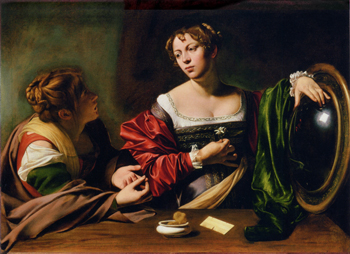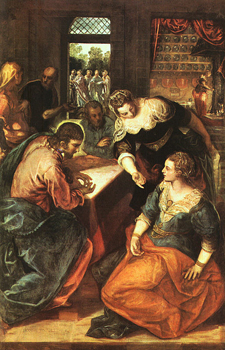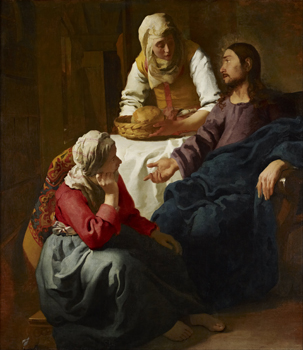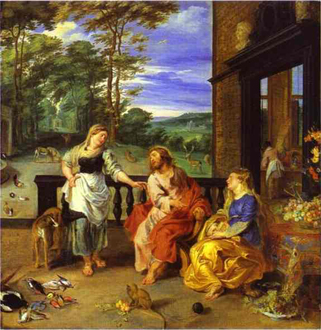Choosing the Better Part:
Jesus at the Home of Mary and Martha
For Sunday July 21, 2013
Lectionary Readings (Revised Common Lectionary, Year C)
Amos 8:1–12 or Genesis 18:1–10
Psalm 52 or Psalm 15
Colossians 1:15–28
Luke 10:38–42
The many Marys of Jesus continue to capture the imagination of people today. Depending on how you parse the fifty references to "Mary" in the New Testament, there might be as many as seven of them.
Chief among the Marys is the mother of Jesus, perhaps the most revered woman in the world. In New York City this summer, the Broadway show The Testament of Mary features this Mary. She's played by the Irish actress Fiona Shaw of Harry Potter fame. The ninety-minute monologue is based upon the 2012 novel of the same name by the Irish writer Colm Tóibín.
 |
Martha and Mary Magdalene by Caravaggio (1598). |
The second most famous Mary is the subject of an opera now playing in San Francisco. The Gospel of Mary Magdalene is written and scored by Mark Adamo. Mary Magdalene might also be the subject of the second-century Gospel of Mary, discovered in 1896, although its fragmentary evidence has lead scholars to disagree about the identity of the main character.
There might be five more Marys in the New Testament. There's "Mary the mother of James and Joseph" (Matthew 27:56). "Mary the wife of Clopas" is mentioned only in John 19:25. She might be "the other Mary" mentioned in Matthew 28:1. Luke mentions "Mary the mother of John, also called Mark" (Acts 12:12), while Paul commends "Mary, who has worked hard for you," in Romans 16:6.
Finally, there's the gospel for this week about Mary of Bethany, the sister of Martha and Lazarus. For many centuries some people identified Mary of Bethany with Mary Magdalene — like Caravaggio in his painting. Today most interpreters think they are different women.
 |
Jesus at the home of Martha and Mary by Tintoretto (16th century). |
The three siblings Mary, Martha and Lazarus are mentioned together three times. All three stories take place in their house in Bethany. They were clearly close friends and supporters of Jesus.
They're mentioned together in the raising of Lazarus in John 11. In the next chapter, John 12, the three siblings host a dinner in their home for Jesus at which Mary anoints Jesus. Then there's the gospel for this week, told only in Luke 10, when Mary and Martha host Jesus in their home. Lazarus isn't mentioned in this story.
"Now as they went on their way, he entered a certain village, where a woman named Martha welcomed him into her home. She had a sister named Mary, who sat at the Lord's feet and listened to what he was saying. But Martha was distracted by her many tasks; so she came to him and asked, 'Lord, do you not care that my sister has left me to do all the work by myself? Tell her then to help me.' But the Lord answered her, 'Martha, Martha, you are worried and distracted by many things; there is need of only one thing. Mary has chosen the better part, which will not be taken away from her.'"
The parable of the Good Samaritan that comes right before this story elucidates the second greatest commandment to love our neighbor. The story of Mary and Martha commends the first and greatest commandment to love God. The story records the only time that Jesus rebuked a person for their devotion to him.
Some people construe this story as privileging the contemplative life over the active life, but that's a false distinction. There's no reason to pit action against contemplation. We need both, and God calls people to both. Indeed, many activists are deeply contemplative, while many solitaries are fully engaged with the world.
 |
Christ in the House of Martha and Mary by Vermeer (1655). |
Instead of contrasting the active and contemplative styles of life, Luke contrasts Martha's "distracted" life — a word he uses twice, with Mary's "centered" life. How ironic that Martha’s earnest acts of devotion precipitated aggravation and annoyance.
The Trappist monk Thomas Merton (1915–1968) spent twenty-seven years cloistered in Gethsemane Monastery in rural Kentucky. His monastic life of silence and prayer invigorated his prophetic writings that spoke to the entire world — and that turned him into a paradoxical silent speaker and celebrity in solitude. His solitude and contemplation fostered engagement with the world rather than an escape from reality.
In the third century some Christians abandoned the frenzy of the cities for the solitude of the desert. In monastic communities and as solitary hermits they renounced the world, shed their possessions, and engaged in ascetic practices that today evoke incredulity. But this was no superficial quest. The real spiritual struggle took place in the interior of the heart and not in the exterior renunciation of material things.
The outer geography of the desert was hard enough; the inner geography of the heart was harder still. Fighting hunger from fasting or devoting one’s sexuality to celibacy were relatively simple compared to battling rage, unconscious urges, unsavory dreams, depression, regret, envy, superficiality, and lust. John Cassian once wondered why a monk who had renounced great wealth would get angry at a dull stylus.
St. Hesychios observes that “he who has renounced such things as marriage, possessions and other worldly pursuits is outwardly a monk, but may not yet be a monk inwardly. It is easy to be a monk in one’s outer self if one wants to be; but no small struggle is required to be a monk in one’s inner self.” Withdrawing to the desert for contemplation is no guarantee of centeredness or protection against distraction.
 |
Christ in the House of Martha and Mary by Breughel and Rubens (1628). |
Dag Hammarskjold famously observed that the longest journey is the journey inward. In our age of Total Information Overload, it's “no small struggle” to move from the experience of Martha, distracted, agitated, and anxious, to Mary's quiet, centered interiority. But that's how and where we experience the love of God.
Two poems in particular have helped me to follow Mary instead of Martha. In Today, Mary Oliver commends stillness as "one of the doors into the temple." And in Let Your God Love You, Edwina Gateley encourages us to do nothing, say nothing, and ask nothing except to sense the immensity of God's love. That's what Mary did. She "chose the better part" that was "the one thing needful."
Image credits: (1) Wikipedia.org; (2) Wikipedia.org; (3) Wikipedia.org; and (4) Wikimedia.org.





